Thermo-Convective Solution Growth of Vertically Aligned Zinc Oxide Nanowire Arrays for Piezoelectric Energy Harvesting
Abstract
1. Introduction
2. Materials and Methods
2.1. Investigation of SL Thickness on Morphology of ZnO NWAs
2.2. Temperature Optimization for Experimental Setup
- The volume of the reaction container was large, resulting in a large surface area in contact with the cooling water. This was detrimental to the temperature stability required for the precursor solution. Also, the external cooling system’s effectiveness (together with the cooling water) was higher than the heating element’s heating efficiency. As a result, it was challenging to control and maintain a stable growth temperature.
- The temperature achieved in the reaction container differed from the input temperature shown on the temperature controller. This was because the PT100 temperature sensor that was utilized in the heating system was mounted inside the heating element rather than on its surface. Consequently, there were additional materials with increased thermal resistance between the thermal resistor and the PT100. These included pore space at the interface between the heating element and the solution, a 2 mm thick aluminum sheet for hermetic packaging, graphite sheets to aid heat dissipation, and a specified thickness of the Si substrate.
2.3. ZnO NWA Growth
2.4. Characterization of ZnO Crystal Structures
2.5. Fabrication of ZnO-Based PENG
3. Results and Discussion
3.1. Effect of SL Thickness on Morphology of ZnO NWAs
3.2. Structural Properties of ZnO Seed Layer and ZnO NWAs
3.3. Output of PENG with Longer ZnO NWAs
4. Conclusions and Outlook
Supplementary Materials
Author Contributions
Funding
Data Availability Statement
Acknowledgments
Conflicts of Interest
References
- Liu, P.; Li, Y.; Guo, Y.; Zhang, Z. Growth of catalyst-free high-quality ZnO nanowires by thermal evaporation under air ambient. Nanoscale Res. Lett. 2012, 7, 220. [Google Scholar] [CrossRef] [PubMed]
- Wu, W.; Yeh, C.; Ting, J. Effects of Seed Layer Characteristics on the Synthesis of ZnO Nanowires. J. Am. Ceram. Soc. 2009, 92, 2718–2723. [Google Scholar] [CrossRef]
- Chakraborty, A.; Orsini, A.; Kar, J.P.; Gatta, F.; Khan, U.; Falconi, C. Ultra-efficient thermo-convective solution-growth of ver-tically aligned ZnO nanowires. Nano Energy 2022, 97, 107167. [Google Scholar] [CrossRef]
- Kiliç, B.; Wang, L.; Ozdemir, O.; Lu, M.; Tüzemen, S. One-Dimensional (1D) ZnO Nanowires Dye Sensitized Solar Cell. J. Nanosci. Nanotechnol. 2013, 13, 333–338. [Google Scholar] [CrossRef] [PubMed]
- Abdulrahman, A.F.; Ahmed, S.M.; Ahmed, N.M.; Almessiere, M.A. Enhancement of ZnO Nanorods Properties Using Modified Chemical Bath Deposition Method: Effect of Precursor Concentration. Crystals 2020, 10, 386. [Google Scholar] [CrossRef]
- Abdulrahman, A.F.; Ahmed, S.M.; Barzinjy, A.A.; Hamad, S.M.; Ahmed, N.M.; Almessiere, M.A. Fabrication and Characterization of High-Quality UV Photodetectors Based ZnO Nanorods Using Traditional and Modified Chemical Bath Deposition Methods. Nanomaterials 2021, 11, 677. [Google Scholar] [CrossRef]
- Galstyan, V.; Comini, E.; Ponzoni, A.; Sberveglieri, V.; Sberveglieri, G. ZnO Quasi-1D Nanostructures: Synthesis, Modeling, and Properties for Applications in Conductometric Chemical Sensors. Chemosensors 2016, 4, 6. [Google Scholar] [CrossRef]
- Zhu, G.; Zhou, Y.; Wang, S.; Yang, R.; Ding, Y.; Wang, X.; Bando, Y.; Wang, Z.L. Synthesis of vertically aligned ultra-long ZnO nanowires on heterogeneous substrates with catalyst at the root. Nanotechnology 2012, 23, 055604. [Google Scholar] [CrossRef]
- Zhang, L.; Zhou, R.; Ma, W.; Lu, H.; Mo, Y.; Wang, Y.; Bao, R.; Pan, C. Junction Piezotronic Transistor Arrays Based on Patterned ZnO Nanowires for High-Resolution Tactile and Photo Mapping. Sensors 2024, 24, 4775. [Google Scholar] [CrossRef]
- Anang, F.E.B.; Wang, Z.; Xu, J.; Schmidt, A.; Cain, M.; Peiner, E. Zinc Oxide Nanowire Arrays Growth on Patterned Silicon Substrate for Piezoelectric Energy Harvesting. In Mikro-Nano-Integration; GMM-Workshop: Aachen, Germany, 2022; pp. 1–5. [Google Scholar]
- Dakua, I.; Afzulpurkar, N. Piezoelectric Energy Generation and Harvesting at the Nano-Scale: Materials and Devices. Nanomater. Nanotechnol. 2013, 3, 21. [Google Scholar] [CrossRef]
- Gaddam, V., Joshi, S., Parmar, M., Rajanna, K., Nayak, M.M., Eds.; A novel piezoelectric ZnO nanogenerator on flexible metal alloy substrate. In Proceedings of the Sensors IEEE, Tapei, Taiwan, 28–31 October 2012; pp. 1–4. [Google Scholar] [CrossRef]
- Wang, Z.L.; Song, J. Piezoelectric Nanogenerators Based on Zinc Oxide Nanowire Arrays. Science 2006, 312, 242–246. [Google Scholar] [CrossRef] [PubMed]
- Sam, A.; Natraj, V.; Marappan, G.; Sivalingam, Y.; Surya, V.J. Design and development of novel piezoelectric nanogenerator based on pH dependent ZnO nanostructures. Mater. Lett. 2021, 294, 129798. [Google Scholar] [CrossRef]
- Indira, S.S.; Vaithilingam, C.A.; Oruganti, K.S.P.; Mohd, F.; Rahman, S. Nanogenerators as a Sustainable Power Source: State of Art, Applications, and Challenges. Nanomaterials 2019, 9, 773. [Google Scholar] [CrossRef] [PubMed]
- Xiong, J.; Lee, P.S. Progress on wearable triboelectric nanogenerators in shapes of fiber, yarn, and textile. Sci. Technol. Adv. Mater. 2019, 20, 837–857. [Google Scholar] [CrossRef] [PubMed]
- Wang, Z.L.; Wang, A.C. On the origin of contact-electrification. Mater. Today Proc. 2019, 30, 34–51. [Google Scholar] [CrossRef]
- Shao, J.; Willatzen, M.; Wang, Z.L. Theoretical modeling of triboelectric nanogenerators (TENGs). J. Appl. Phys. 2020, 128, 111101. [Google Scholar] [CrossRef]
- Yang, Y.; Pradel, K.C.; Jing, Q.; Wu, J.M.; Zhang, F.; Zhou, Y.; Zhang, Y.; Wang, Z.L. Thermoelectric Nanogenerators Based on Single Sb-Doped ZnO Micro/Nanobelts. ACS Nano 2012, 6, 6984–6989. [Google Scholar] [CrossRef]
- Mohammadnia, A.; Rezania, A. Pyroelectric energy harvesting from power electronic substrates. Energy Convers. Manag. 2023, 290, 117233. [Google Scholar] [CrossRef]
- Li, H.; Koh, C.S.L.; Lee, Y.H.; Zhang, Y.; Phan-Quang, G.C.; Zhu, C.; Liu, Z.; Chen, Z.; Sim, H.Y.F.; Lay, C.L.; et al. A wearable solar-thermal-pyroelectric harvester: Achieving high power output using modified rGO-PEI and polarized PVDF. Nano Energy 2020, 73, 104723. [Google Scholar] [CrossRef]
- Supraja, P.; Rakesh Kumar, R.; Mishra, S.; Haranath, D.; Sankar, P.R.; Prakash, K. A simple and low-cost approach for the synthesis and fabrication of ZnO nanosheet-based nanogenerator for energy harvesting and sensing. Eng. Res. Express 2021, 3, 035022. [Google Scholar] [CrossRef]
- Anang, F.E.B.; Wei, X.; Xu, J.; Cain, M.; Li, Z.; Brand, U.; Peiner, E. Area-Selective Growth of Zinc Oxide Nanowire Arrays for Piezoelectric Energy Harvesting. Micromachines 2024, 15, 261. [Google Scholar] [CrossRef] [PubMed]
- Sugavaneshwar, R.P.; Nanda, K.K. Ultralong ZnO nanowires: Problems and prospects. Mater. Express 2013, 3, 185–200. [Google Scholar] [CrossRef]
- Gu, L.; Cui, N.; Cheng, L.; Xu, Q.; Bai, S.; Yuan, M.; Wu, W.; Liu, J.; Zhao, Y.; Ma, F.; et al. Flexible Fiber Nanogenerator with 209 V Output Voltage Directly Powers a Light-Emitting Diode. Nano Lett. 2012, 13, 91–94. [Google Scholar] [CrossRef] [PubMed]
- Justeau, C.; Tlemcani, T.S.; Poulin-Vittrant, G.; Nadaud, K.; Alquier, D. A Comparative Study on the Effects of Au, ZnO and AZO Seed Layers on the Performance of ZnO Nanowire-Based Piezoelectric Nanogenerators. Materials 2019, 12, 2511. [Google Scholar] [CrossRef]
- Zhang, X.; Villafuerte, J.; Consonni, V.; Capsal, J.-F.; Cottinet, P.-J.; Petit, L.; Le, M.-Q. Characterizing and Optimizing Piezoelectric Response of ZnO Nanowire/PMMA Composite-Based Sensor. Nanomaterials 2021, 11, 1712. [Google Scholar] [CrossRef]
- Serairi, L.; Yu, D.; Leprince-Wang, Y. Numerical modeling and simulation of ZnO nanowire devices for energy harvesting. Phys. Status Solidi C 2016, 13, 683–687. [Google Scholar] [CrossRef]
- Cardoso, J.; Oliveira, F.F.; Proenca, M.P.; Ventura, J. The Influence of Shape on the Output Potential of ZnO Nanostructures: Sensitivity to Parallel versus Perpendicular Forces. Nanomaterials 2018, 8, 354. [Google Scholar] [CrossRef]
- Xu, S.; Wei, Y.; Kirkham, M.; Liu, J.; Mai, W.; Davidovic, D.; Snyder, R.L.; Wang, Z.L. Patterned Growth of Vertically Aligned ZnO Nanowire Arrays on Inorganic Substrates at Low Temperature without Catalyst. J. Am. Chem. Soc. 2008, 130, 14958–14959. [Google Scholar] [CrossRef]
- Amin, G.; Asif, M.H.; Zainelabdin, A.; Zaman, S.; Nur, O.; Willander, M. Influence of pH, Precursor Concentration, Growth Time, and Temperature on the Morphology of ZnO Nanostructures Grown by the Hydrothermal Method. J. Nanomater. 2011, 2011, 269692. [Google Scholar] [CrossRef]
- Tao, Y.; Fu, M.; Zhao, A.; He, D.; Wang, Y. The effect of seed layer on morphology of ZnO nanorod arrays grown by hydrothermal method. J. Alloys Compd. 2009, 489, 99–102. [Google Scholar] [CrossRef]
- Nour, E.S.; Nur, O.; Willander, M. Zinc oxide piezoelectric nano-generators for low frequency applications. Semicond. Sci. Technol. 2017, 32, 064005. [Google Scholar] [CrossRef]
- Le, A.T.; Ahmadipour, M.; Pung, S.-Y. A review on ZnO-based piezoelectric nanogenerators: Synthesis, characterization techniques, performance enhancement and applications. J. Alloys Compd. 2020, 844, 156172. [Google Scholar] [CrossRef]
- Poulin-Vittrant, G.; Dahiya, S.A.S.; Boubenia, S.; Nadaud, K.; Morini, F.; Justeau, C. Challenges of low-temperature synthesized ZnO nanostructures and their integration into nano-systems. Mater. Sci. Semicond. Process. 2019, 91, 404–408. [Google Scholar] [CrossRef]
- Abubakar, S.; Chyi, J.L.Y.; Tan, S.T.; Sagadevan, S.; Talib, Z.A.; Paiman, S. Nanoscale domain imaging and the electromechanical response of zinc oxide nanorod arrays synthesized on different substrates. J. Mater. Res. Technol. 2021, 14, 2451–2463. [Google Scholar] [CrossRef]
- Xu, J.; Strempel, K.; Zhou, H.; Waag, A.; Bertke, M.; Schmidt, A.; Peiner, E. Area-Selective Growth of Aligned ZnO Nanorod Arrays for MEMS Device Applications. Proceedings 2018, 2, 887. [Google Scholar] [CrossRef]
- Pradel, K.C.; Uzuhashi, J.; Takei, T.; Ohkubo, T.; Hono, K.; Fukata, N. Investigation of nanoscale voids in Sb-doped p-type ZnO nanowires. Nanotechnology 2018, 29, 335204. [Google Scholar] [CrossRef]
- Tlemcani, T.S.; Justeau, C.; Nadaud, K.; Alquier, D.; Poulin-Vittrant, G. Fabrication of Piezoelectric ZnO Nanowires Energy Harvester on Flexible Substrate Coated with Various Seed Layer Structures. Nanomaterials 2021, 11, 1433. [Google Scholar] [CrossRef]
- Qu, X.; Fu, Y.; Duan, Z.; Li, M.; Zhong, Y.H.; Ma, L. Characterization and ohmic contact of hydrothermally synthesized vertical ZnO and Ag/ZnO nanowires. Mater. Res. Express 2022, 9, 125003. [Google Scholar] [CrossRef]
- Xu, J.; Bertke, M.; Gad, A.; Yu, F.; Hamdana, G.; Bakin, A.; Peiner, E. Fabrication of ZnO Nanorods on MEMS Piezoresistive Silicon Microcantilevers for Environmental Monitoring. Proceedings 2017, 1, 290. [Google Scholar] [CrossRef]
- Guillemin, S.; Consonni, V.; Appert, E.; Puyoo, E.; Rapenne, L.; Roussel, H. Critical Nucleation Effects on the Structural Relationship Between ZnO Seed Layer and Nanowires. J. Phys. Chem. C 2012, 116, 25106–25111. [Google Scholar] [CrossRef]
- Song, J.; Lim, S. Effect of Seed Layer on the Growth of ZnO Nanorods. J. Phys. Chem. C 2007, 111, 596–600. [Google Scholar] [CrossRef]
- Ghayour, H.; Rezaie, H.; Mirdamadi, S.; Nourbakhsh, A. The effect of seed layer thickness on alignment and morphology of ZnO nanorods. Vacuum 2011, 86, 101–105. [Google Scholar] [CrossRef]
- Tlemcani, T.S.; Justeau, C.; Nadaud, K.; Poulin-Vittrant, G.; Alquier, D. Deposition Time and Annealing Effects of ZnO Seed Layer on Enhancing Vertical Alignment of Piezoelectric ZnO Nanowires. Chemosensors 2019, 7, 7. [Google Scholar] [CrossRef]
- Sugunan, A.; Warad, H.C.; Boman, M.; Dutta, J. Zinc oxide nanowires in chemical bath on seeded substrates: Role of hexamine. J. Sol-Gel Sci. Technol. 2006, 39, 49–56. [Google Scholar] [CrossRef]
- Hinchet, R.; Lee, S.; Ardila, G.; Montès, L.; Mouis, M.; Wang, Z.L. Performance Optimization of Vertical Nanowire-based Piezoelectric Nanogenerators. Adv. Funct. Mater. 2014, 24, 971–977. [Google Scholar] [CrossRef]
- Panchal, V.; Yang, Y.; Cheng, G.; Hu, J.; Kruskopf, M.; Liu, C.-I.; Rigosi, A.F.; Melios, C.; Walker, A.R.H.; Newell, D.B.; et al. Confocal laser scanning microscopy for rapid optical characterization of graphene. Commun. Phys. 2018, 1, 83. [Google Scholar] [CrossRef]
- Baca, R.; Juárez, G.; Solache, H.; Andraca, J.; Martinez, J.; Garcia, O.; Kryshtab, T.; Peña-Sierra, R. Kinetics of the oxidation of Zn foils in air atmosphere. IOP Conf. Series Mater. Sci. Eng. 2010, 8, 012043. [Google Scholar] [CrossRef]
- ISO 4287-1996; Geometrical Product Specifications (GPS)—Surface Texture: Profile Method—Terms, Definitions and Parameters of Surface Texture. ISO: Geneva, Switzerland, 1996.
- Ou, C.; Sanchez-Jimenez, P.E.; Datta, A.; Boughey, F.L.; Whiter, R.A.; Sahonta, S.-L.; Kar-Narayan, S. Template-Assisted Hydrothermal Growth of Aligned Zinc Oxide Nanowires for Piezoelectric Energy Harvesting Applications. ACS Appl. Mater. Interfaces 2016, 8, 13678–13683. [Google Scholar] [CrossRef]
- Wang, L.; Zhang, X.; Zhao, S.; Zhou, G.; Zhou, Y.; Qi, J. Synthesis of well-aligned ZnO nanowires by simple physical vapor deposition on c-oriented ZnO thin films without catalysts or additives. Appl. Phys. Lett. 2005, 86, 024108. [Google Scholar] [CrossRef]
- Kammel, R.S.; Sabry, R.S. Effects of the aspect ratio of ZnO nanorods on the performance of piezoelectric nanogenerators. J. Sci. Adv. Mater. Devices 2019, 4, 420–424. [Google Scholar] [CrossRef]
- Sahu, S.; Samanta, P.K. Peak Profile Analysis of X-ray Diffraction Pattern of Zinc Oxide Nanostructure. J. Nano-Electron. Phys. 2021, 13, 05001-1–05001-4. [Google Scholar] [CrossRef] [PubMed]
- Abdulrahman, A.F.; Barzinjy, A.A.; Hamad, S.M.; Almessiere, M.A. Impact of Radio Frequency Plasma Power on the Structure, Crystallinity, Dislocation Density, and the Energy Band Gap of ZnO Nanostructure. ACS Omega 2021, 6, 31605–31614. [Google Scholar] [CrossRef] [PubMed]
- Nizar, B.M.; Lajnef, M.; Chaste, J.; Chtourou, R.; Herth, E. Highly C-oriented (002) plane ZnO nanowires synthesis. RSC Adv. 2023, 13, 15077–15085. [Google Scholar] [CrossRef] [PubMed]
- Singh, A.; Vishwakarma, H.L. Study of structural, morphological, optical and electroluminescent properties of undoped ZnO nanorods grown by a simple chemical precipitation. Mater. Sci.-Pol. 2015, 33, 751–759. [Google Scholar] [CrossRef]
- Moussa, B.B.; Lajnef, M.; Jebari, N.; Villebasse, C.; Bayle, F.; Chaste, J.; Madouri, A.; Chtourou, R.; Herth, E. Synthesis of ZnO sol-gel thin-films CMOS-Compatible. RSC Adv. 2021, 11, 22723–22733. [Google Scholar] [CrossRef]
- Lupan, O.; Emelchenko, G.; Ursaki, V.; Chai, G.; Redkin, A.; Gruzintsev, A.; Tiginyanu, I.; Chow, L.; Ono, L.; Cuenya, B.R.; et al. Synthesis and characterization of ZnO nanowires for nanosensor applications. Mater. Res. Bull. 2010, 45, 1026–1032. [Google Scholar] [CrossRef]
- Rivera, V.F.; Auras, F.; Motto, P.; Stassi, S.; Canavese, G.; Celasco, E.; Bein, T.; Onida, B.; Cauda, V. Length-Dependent Charge Generation from Vertical Arrays of High-Aspect-Ratio ZnO Nanowires. Chem.–A Eur. J. 2013, 19, 14665–14674. [Google Scholar] [CrossRef]
- Briscoe, J.; Jalali, N.; Woolliams, P.; Stewart, M.; Weaver, P.M.; Cain, M.; Dunn, S. Measurement techniques for piezoelectric nanogenerators. Energy Environ. Sci. 2013, 6, 3035–3045. [Google Scholar] [CrossRef]
- Serairi, L.; Leprince-Wang, Y. ZnO Nanowire-Based Piezoelectric Nanogenerator Device Performance Tests. Crystals 2022, 12, 1023. [Google Scholar] [CrossRef]
- Tao, R.; Parmar, M.; Ardila, G.; Oliveira, P.; Marques, D.; Montès, L.; Mouis, M. Performance of ZnO based piezo-generators under controlled compression. Semicond. Sci. Technol. 2017, 32, 064003. [Google Scholar] [CrossRef]
- Oshman, C.; Opoku, C.; Dahiya, A.S.; Alquier, D.; Camara, N.; Poulin-Vittrant, G. Measurement of Spurious Voltages in ZnO Piezoelectric Nanogenerators. J. Microelectromech. Syst. 2016, 25, 533–541. [Google Scholar] [CrossRef]
- Thongma, S.; Boonkoom, T.; Tantisantisom, K.; Krisdanurak, N. Influence of ZnO seed layer on the alignment of hydrothermal growth ZnO NR array and influence of surface area of metal contact on p-n junction diode behavior. Mater. Today Proc. 2018, 5, 15203–15207. [Google Scholar] [CrossRef]
- Ye, T., Xia, F., Wang, J., Chen, L., Eds.; Micropyramid silicon wafer with ZnO nanowires as high efficiency piezoelectric nanogenerator. In Proceedings of the ICEPT 2018: The 19th International Conference on Electronic Packaging Technology, Shanghai, China, 8–11 August 2018; IEEE: Piscataway, NJ, USA, 2018. [Google Scholar]
- Poulin-Vittrant, G.; Oshman, C.; Opoku, C.; Dahiya, A.; Camara, N.; Alquier, D.; Hue, L.-P.T.H.; Lethiecq, M. Fabrication and Characterization of ZnO Nanowire-based Piezoelectric Nanogenerators for Low Frequency Mechanical Energy Harvesting. Phys. Procedia 2015, 70, 909–913. [Google Scholar] [CrossRef]
- Yu, A.; Li, H.; Tang, H.; Liu, T.; Jiang, P.; Wang, Z.L. Vertically integrated nanogenerator based on ZnO nanowire arrays. Phys. Status Solidi (RRL)–Rapid Res. Lett. 2011, 5, 162–164. [Google Scholar] [CrossRef]
- Shin, D.-M.; Tsege, E.L.; Kang, S.H.; Seung, W.; Kim, S.-W.; Kim, H.K.; Hong, S.W.; Hwang, Y.-H. Freestanding ZnO nanorod/graphene/ZnO nanorod epitaxial double heterostructure for improved piezoelectric nanogenerators. Nano Energy 2015, 12, 268–277. [Google Scholar] [CrossRef]
- Sun, Y.; Zheng, Y.; Wang, R.; Fan, J.; Liu, Y. Direct-current piezoelectric nanogenerator based on two-layer zinc oxide nanorod arrays with equal c-axis orientation for energy harvesting. Chem. Eng. J. 2021, 426, 131262. [Google Scholar] [CrossRef]
- Nguyen, V.; Zhu, R.; Yang, R. Environmental effects on nanogenerators. Nano Energy 2015, 14, 49–61. [Google Scholar] [CrossRef]
- Hu, Y.; Klein, B.D.B.; Su, Y.; Niu, S.; Liu, Y.; Wang, Z.L. Temperature Dependence of the Piezotronic Effect in ZnO Nanowires. Nano Lett. 2013, 13, 5026–5032. [Google Scholar] [CrossRef]
- Zhu, D.; Fu, Y.; Zang, W.; Zhao, Y.; Xing, L.; Xue, X. Piezo/active humidity sensing of CeO2/ZnO and SnO2/ZnO nanoarray nanogenerators with high response and large detecting range. Sens. Actuators B Chem. 2014, 205, 12–19. [Google Scholar] [CrossRef]
- Yang, D.; Yang, D.; Qiu, Y.; Qiu, Y.; Jiang, Q.; Jiang, Q.; Guo, Z.; Guo, Z.; Song, W.; Song, W.; et al. Patterned growth of ZnO nanowires on flexible substrates for enhanced performance of flexible piezoelectric nanogenerators. Appl. Phys. Lett. 2017, 110, 63901. [Google Scholar] [CrossRef]
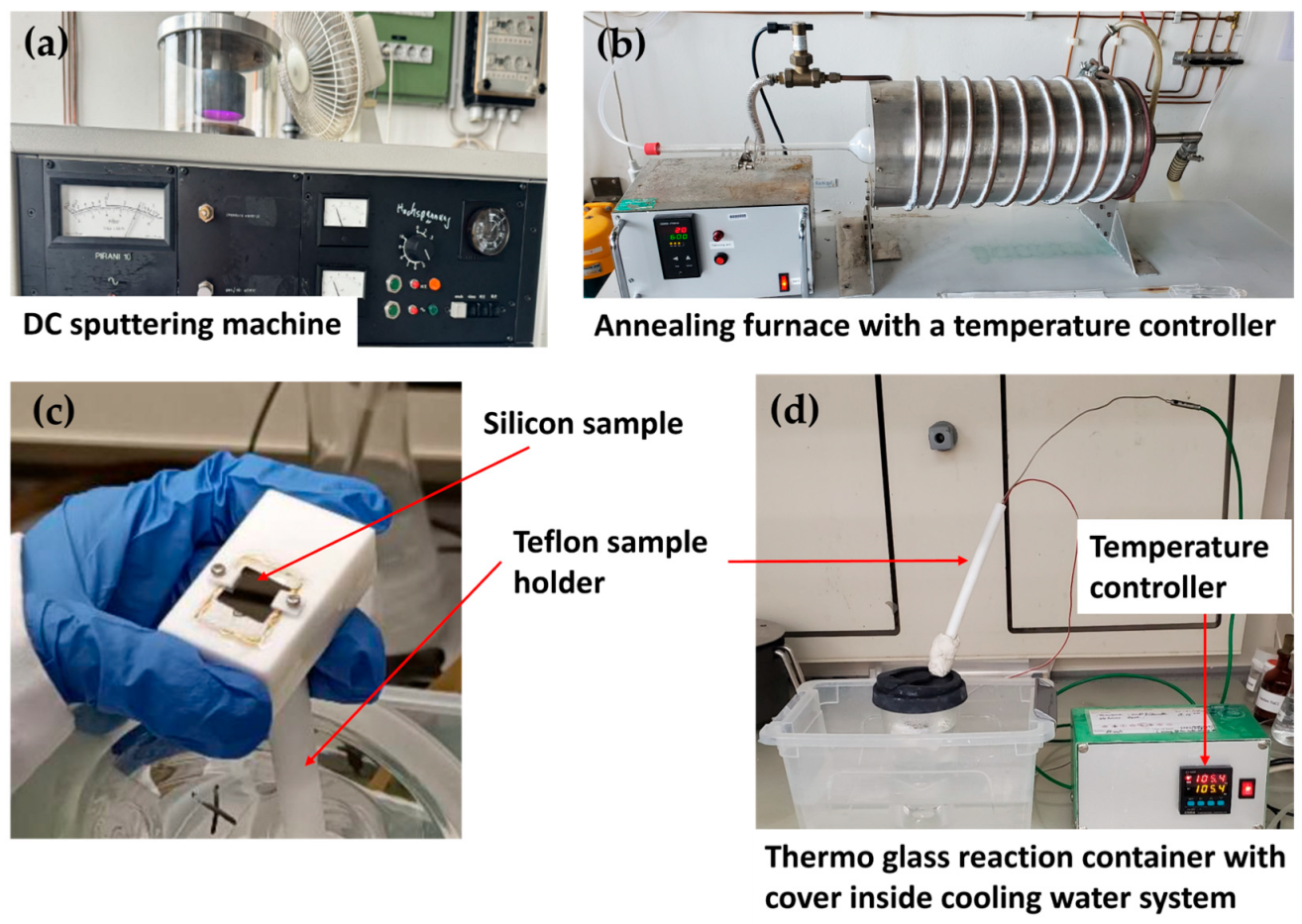

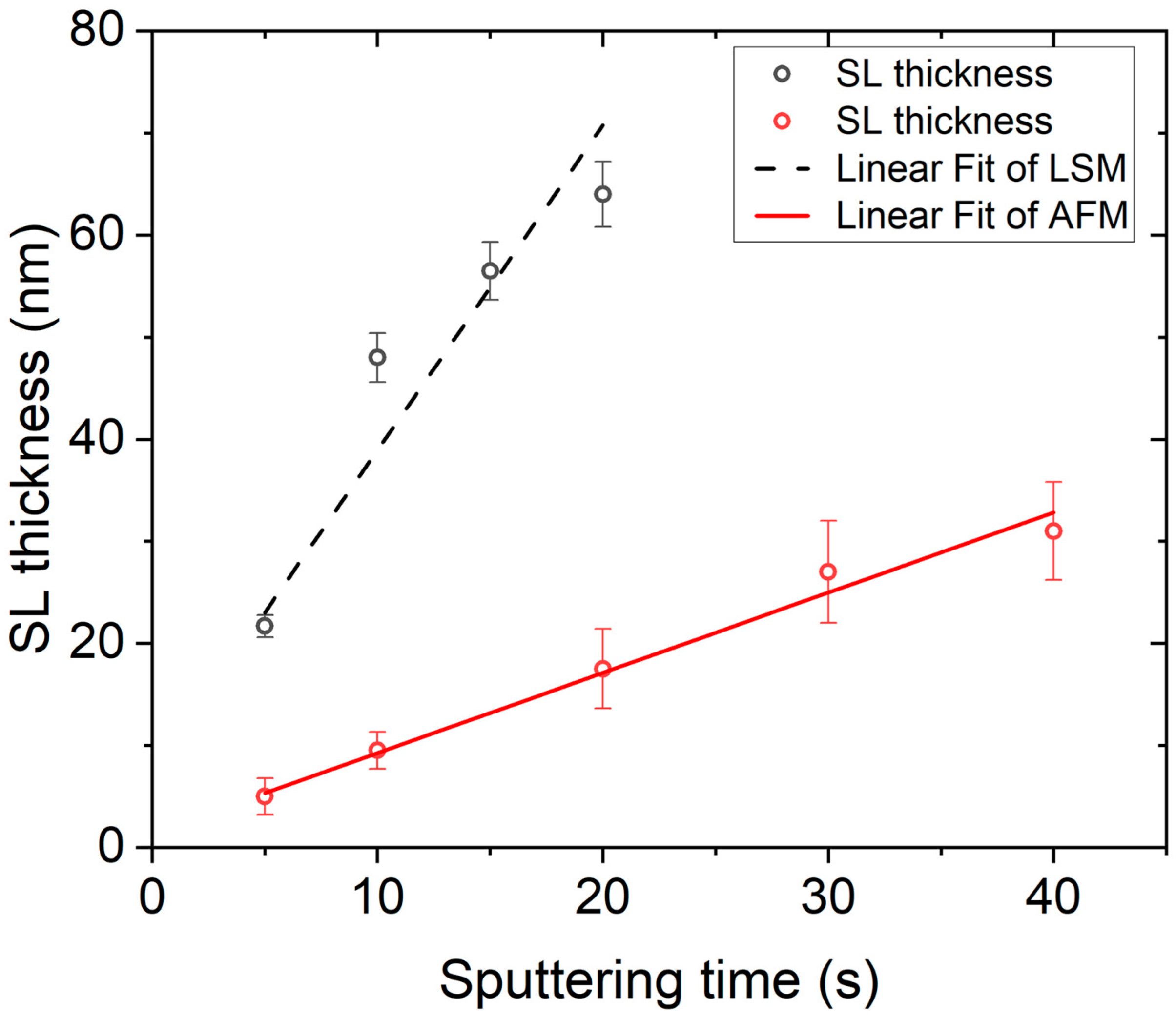

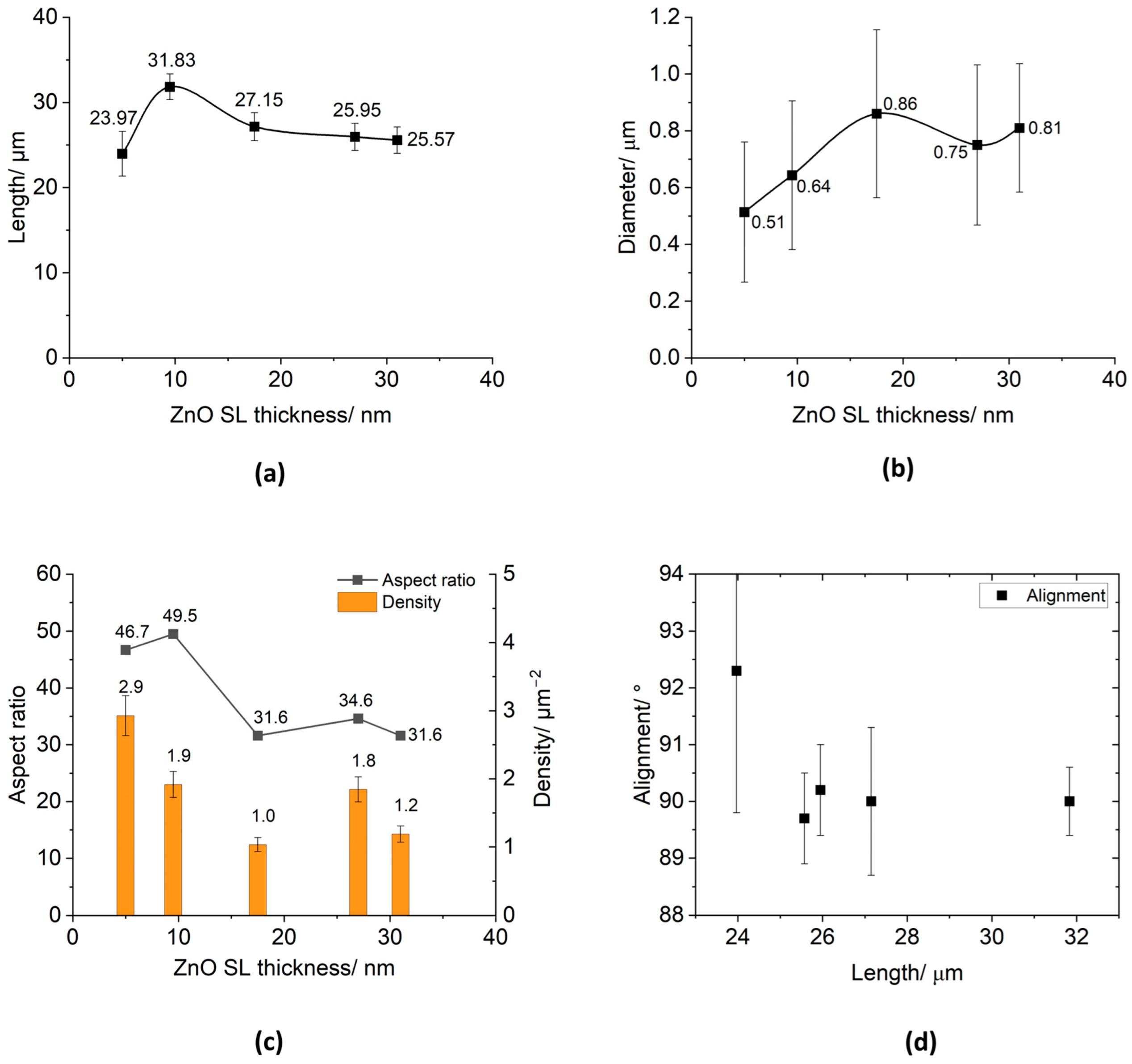

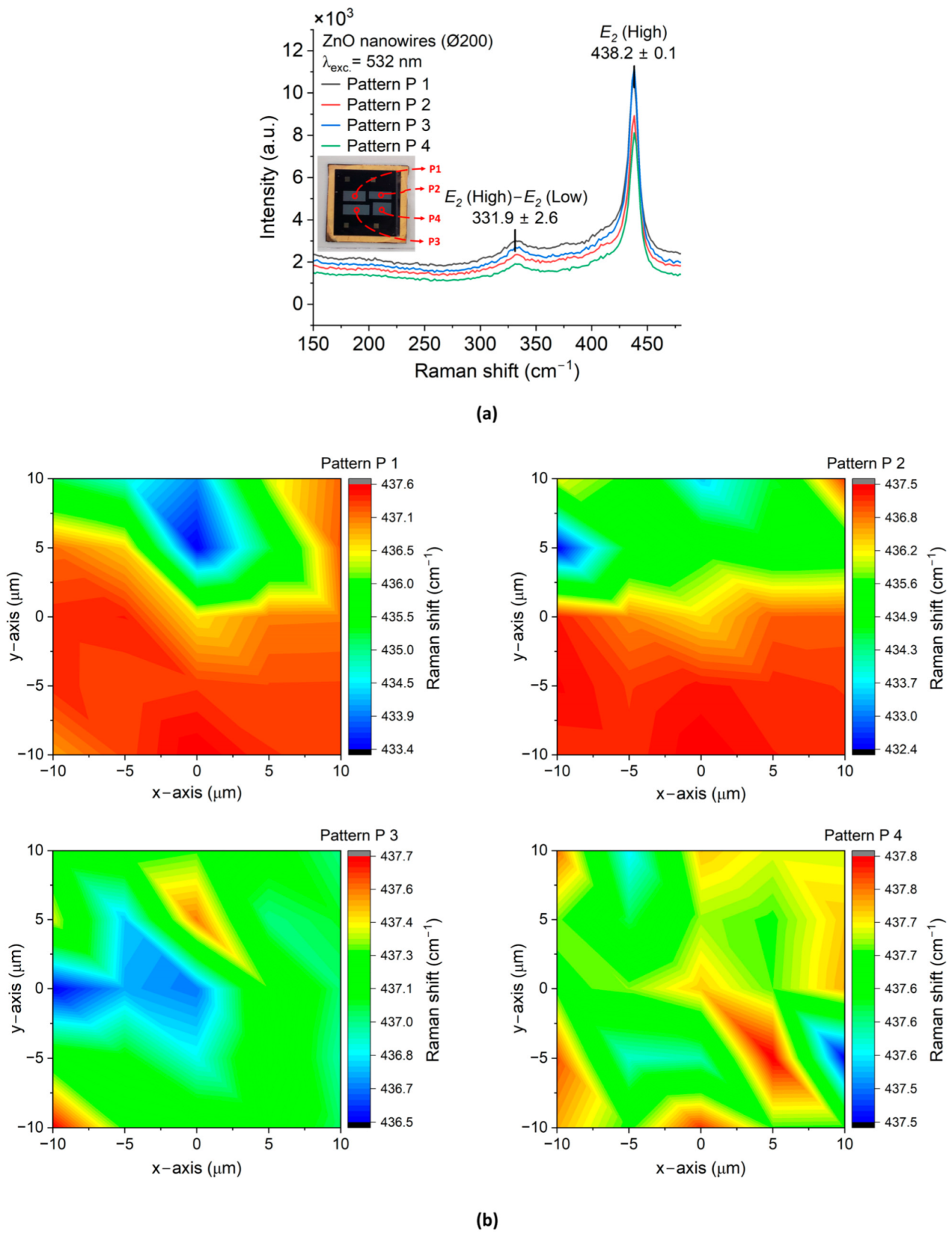
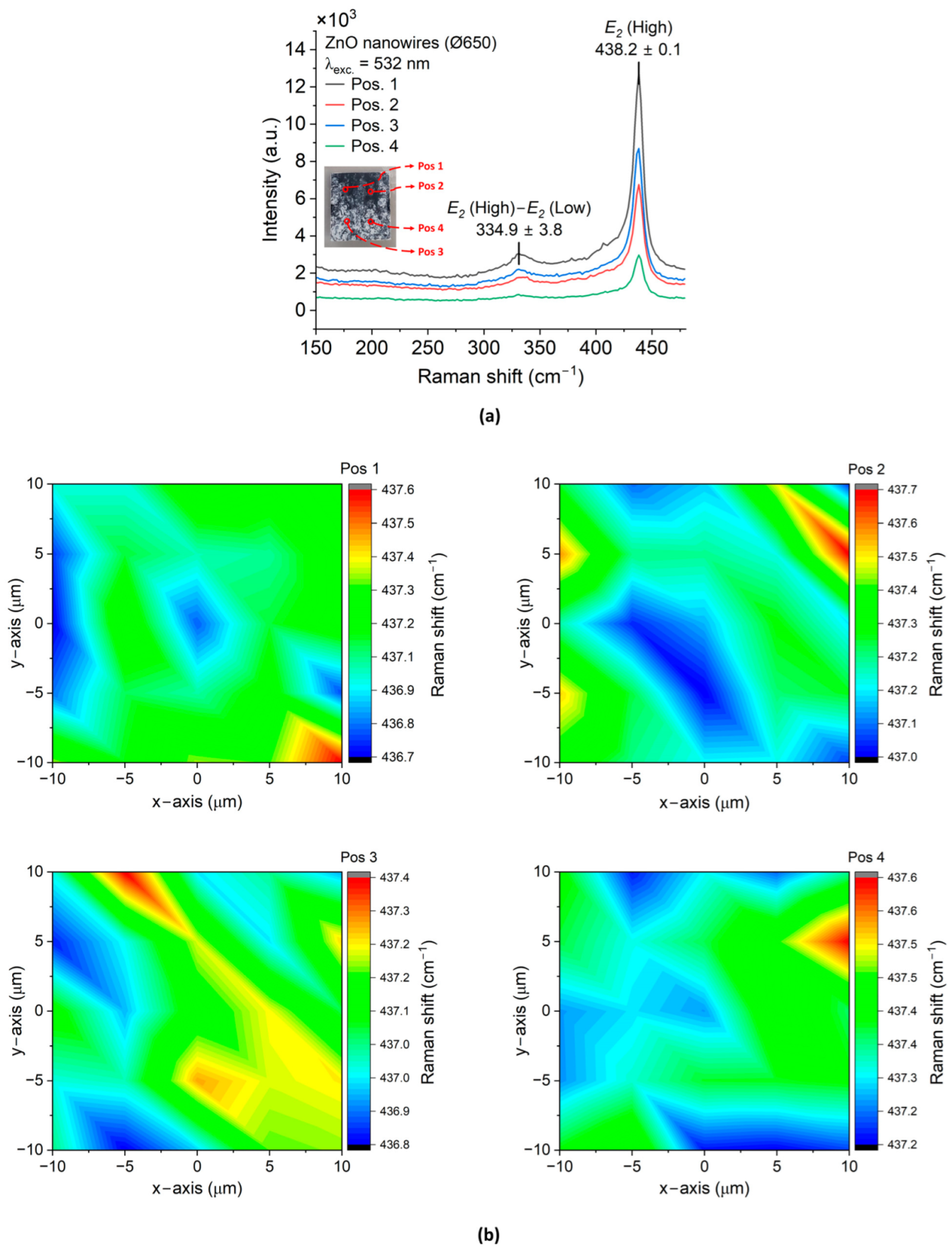
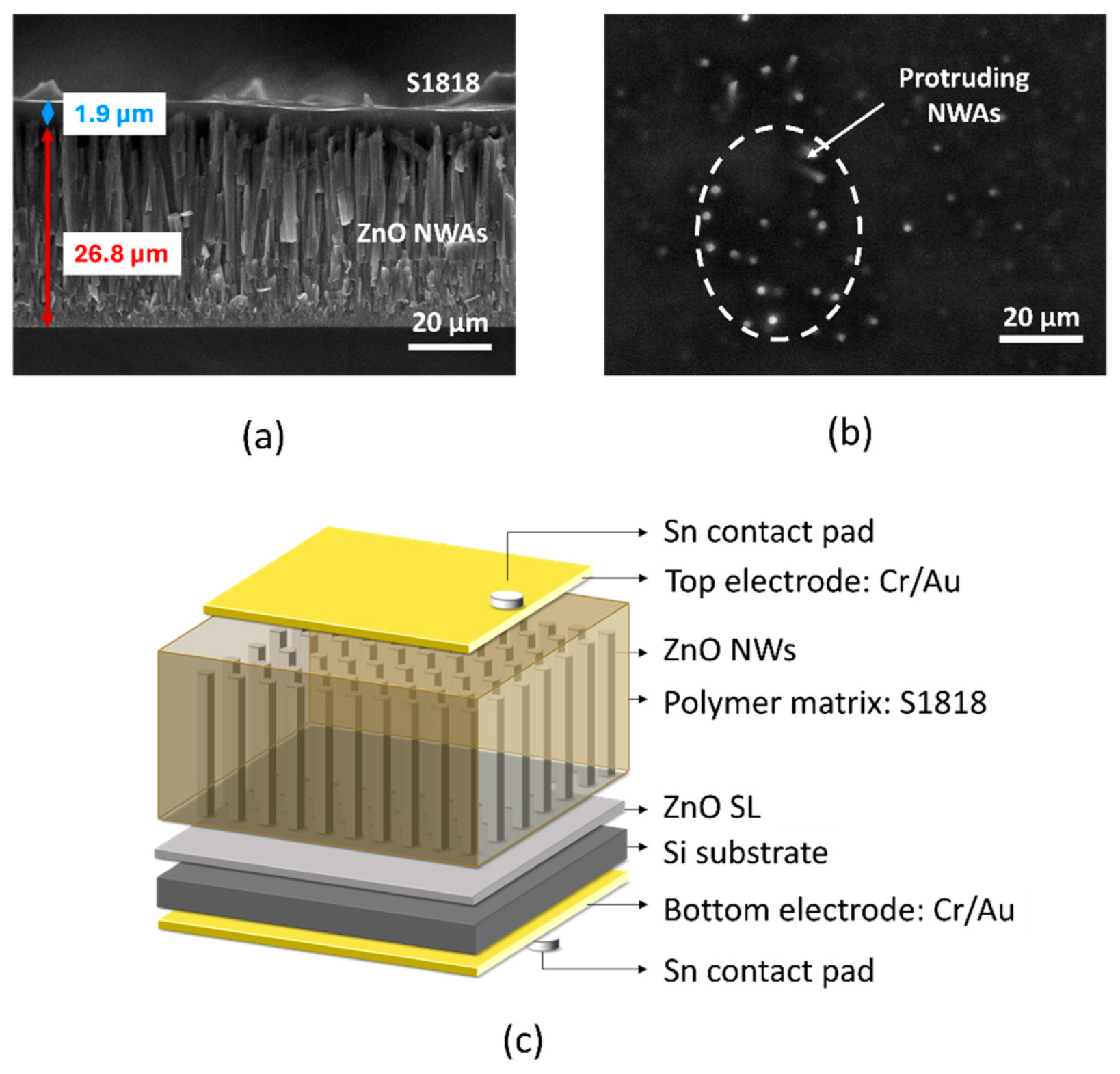
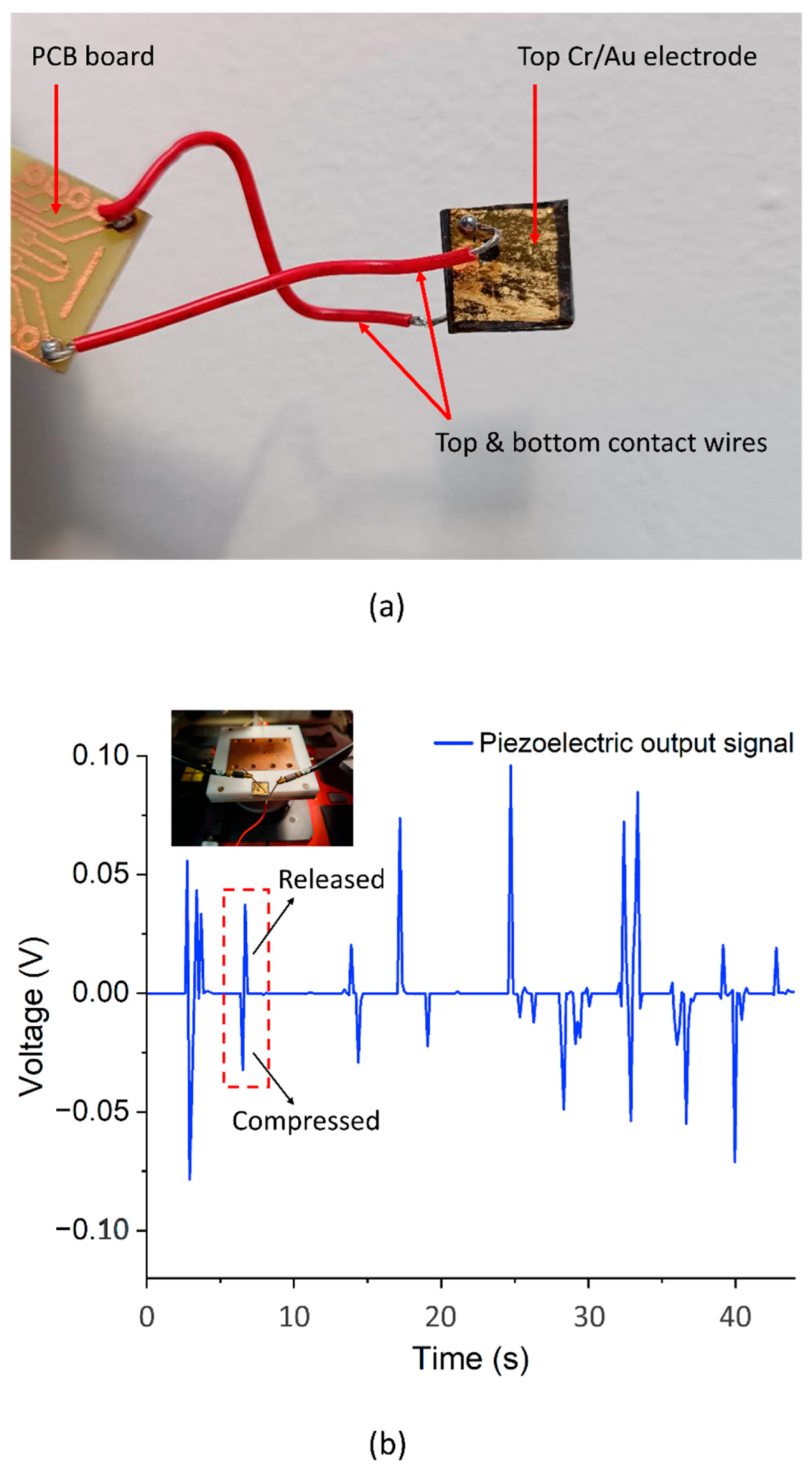
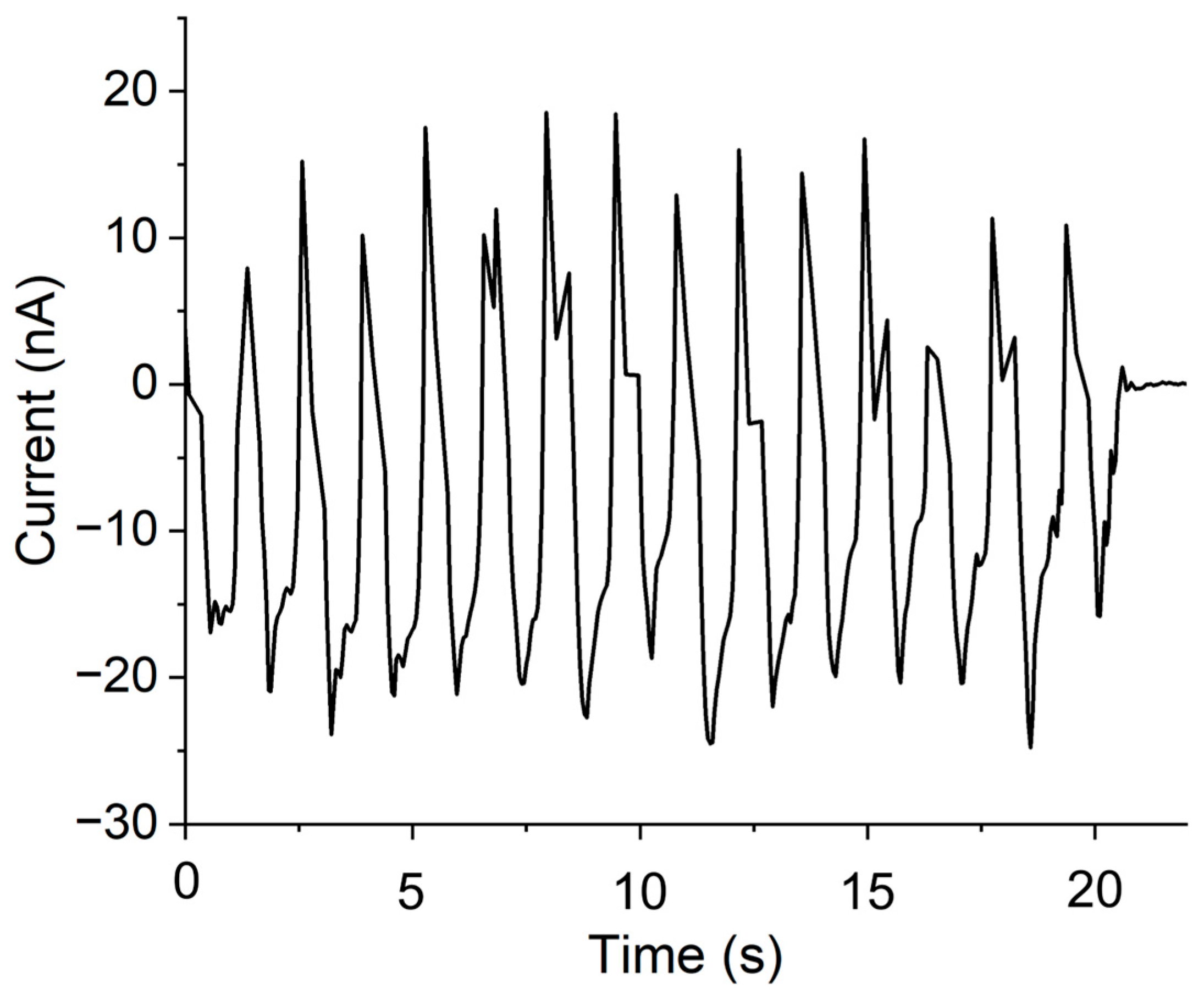
| Sputtering Time (min) | ZnO SL Thickness (nm) | Length-L (µm) | Diameter-Ø (µm) | NW Growth Rate (µm/h) | Aspect Ratio (L/Ø) | Density (µm−2) | Vertical Alignment (°) |
|---|---|---|---|---|---|---|---|
| 1 | - | 35.3 ± 4.3 | 0.8 ± 0.4 | 1.5 | 42.0 | 0.3 | 92.4 ± 6.5 |
| 5 | 5.0 ± 1.8 | 24.0 ± 2.6 | 0.5 ± 0.2 | 1.0 | 46.7 | 2.9 | 92.3 ± 2.5 |
| 10 | 9.5 ± 1.8 | 31.8 ± 1.5 | 0.6 ± 0.3 | 1.3 | 49.5 | 1.9 | 90.0 ± 0.6 |
| 20 | 17.5 ± 3.9 | 27.2 ± 1.6 | 0.9 ± 0.3 | 1.1 | 31.6 | 1.0 | 90.0 ± 1.3 |
| 30 | 27.0 ± 5.0 | 25.9 ± 1.6 | 0.7 ± 0.3 | 1.1 | 34.6 | 1.8 | 90.2 ± 0.8 |
| 40 | 31.0 ± 4.8 | 25.6 ± 1.5 | 0.8 ± 0.2 | 1.1 | 31.6 | 1.2 | 89.7 ± 0.8 |
| NW Growth Method | SL Deposition | NW Growth Rate (µm/h) | Max. NW Length (µm) | Advantages | Drawbacks | |
|---|---|---|---|---|---|---|
| Thermo-convective solution growth (target heating) | Dip coating | 2.0 | 87.0 | Low cost; low energy; low temperature; flexible substrates; fewer chemicals | Global heating; mass-transport limited growth; non-selective-area growth | [3] |
| Hydrothermal | Dip coating | 2.4 | 12 | Low cost; low temperature; fewer chemicals | More chemicals for ultra-long NWs; non-selective-area growth; mass-transport limited growth | [51] |
| Thermal evaporation | Seedless | - | - | Non-catalyst contamination | Capital intensive; high processing temperature; non-selective-area growth; non-flexible substrate | [1] |
| Physical vapor deposition | Pulse laser deposition | - | 4 | Non-catalyst contamination | Capital intensive, high processing temperature; non-selective-area growth; non-flexible substrate; non-homogenous growth | [52] |
| Chemical vapor deposition | RF sputtering | - | 130 | Non-catalyst contamination | High processing temperature; capital intensive; non-selective-area growth; non-flexible substrate | [8] |
| Hydrothermal | Spin-coating | 0.8 | 2.4 | Low temperature; low cost | Non-area-selective growth; mass-transport limited growth | [53] |
| Chemical bath deposition | DC sputtering | 0.6 | 1.8 | Low cost; low temperature; flexible substrate; selective-area growth | NWs growth in all areas; more chemicals for ultra-long NWs | [23] |
| Thermo-convective solution growth (target heating) | DC sputtering | 1.5 | 35.3 | Low cost; low energy; low temperature; flexible substrates; fewer chemicals; selective-area growth | Global heating | This study |
| Layers | NW L (µm) | NW D (nm) | Area (mm2) | Force | Load (R) | Peak Vout | Peak Power | Power Density | |
|---|---|---|---|---|---|---|---|---|---|
| PC/ZnO/PC | 12 | 250 | 30 | impact, 75 Hz | 1 MΩ | 0.3 V | - | 1.6 × 10−3 mW/cm3 | [51] |
| Si/ZnO/SU-8 | 1.8 | 200 | 4 × 8 | 91.5 g (0.9 N) compressive | 100 kΩ | 21.6 mV | 0.017 nW | 0.22 µW/cm3 | [23] |
| Si/ZnO/S1818 | 26.8 | 650 | 15 × 15 | 91.5 g (0.9 N) compressive | 100 kΩ | 95.9 mV | 2.38 nW | 0.37 µW/cm3 | This study |
| Si/ZnO/PMMA | 1.1 | 45 | 7 | 6 N @ 9 Hz compressive | 5 MΩ | 5.6 V | 1.71 µW | 38.47 mW/cm3 | [62] |
| 7 | 6 N @ 500 Hz vibrative | 5 MΩ | 1.4 V | 0.04 µW | 0.9 mW/cm3 | ||||
| Si/ZnO/PMMA | 3 | 200 | 10 | 5 N compressive | 1 MΩ | 0.29 V | 13 nW | 85 µW/cm3 | [63] |
| Si/ZnO/PDMS | 1.5 | 200 | 20 × 20 | 0.451 N @ 10 Hz compressive | - | 3 mV | - | - | [64] |
| p-Si/n-ZnO/PMMA | 1.05 | 65 | - | - | - | 1.77 V | - | - | [65] |
| Si/ZnO/Au/PDMS | 0.9 | 60 | - | 40 kHz | 100 MΩ | 2 V DC | 4.59 pW | - | [66] |
| PDMS/Au/ZnO/Parylene C | 0.59 | 70 | 10 | 3 N @ 5 Hz vibrative | 100 MΩ | 3.9 V | 29 nW | - | [39] |
| PDMS/ITO/ZnO/Parylene C | 0.70 | 70 | 10 | 3 N @ 5 Hz vibrative | 100 MΩ | 6.8 V | 64 nW | - | |
| Phynox metal alloy/Au/ZnO/PMMA | 3 | 170 | 30 × 6 | fingertip impact | - | 0.93 V | - | - | [12] |
| PET/Ni/ZnO/PMMA | 2 | 200 | 25 × 25 | 10 Hz bending | 1 MΩ | 56 mV | - | - | [67] |
| Au/ZnO/PMMA | 4 | 400 | 38 | pressing; 0.5 Hz | - | 15 mV | - | 2.8 nW/cm3 | [68] |
| Graphene/ZnO/PMMA | 2.5 | 100 | - | 49 N compressive | - | 0.17 V | - | 0.004 µW/cm3 | [69] |
| PAN/ZnO/PET | 3 | 140 | 15 × 15 | 10 N, I Hz | 0.45 MΩ | 1.6 V | - | 5.86 µW/cm3 | [70] |
Disclaimer/Publisher’s Note: The statements, opinions and data contained in all publications are solely those of the individual author(s) and contributor(s) and not of MDPI and/or the editor(s). MDPI and/or the editor(s) disclaim responsibility for any injury to people or property resulting from any ideas, methods, instructions or products referred to in the content. |
© 2024 by the authors. Licensee MDPI, Basel, Switzerland. This article is an open access article distributed under the terms and conditions of the Creative Commons Attribution (CC BY) license (https://creativecommons.org/licenses/by/4.0/).
Share and Cite
Anang, F.E.B.; Refino, A.D.; Harm, G.; Li, D.; Xu, J.; Cain, M.; Brand, U.; Li, Z.; Görke, M.; Garnweitner, G.; et al. Thermo-Convective Solution Growth of Vertically Aligned Zinc Oxide Nanowire Arrays for Piezoelectric Energy Harvesting. Micromachines 2024, 15, 1179. https://doi.org/10.3390/mi15101179
Anang FEB, Refino AD, Harm G, Li D, Xu J, Cain M, Brand U, Li Z, Görke M, Garnweitner G, et al. Thermo-Convective Solution Growth of Vertically Aligned Zinc Oxide Nanowire Arrays for Piezoelectric Energy Harvesting. Micromachines. 2024; 15(10):1179. https://doi.org/10.3390/mi15101179
Chicago/Turabian StyleAnang, Frank Eric Boye, Andam Deatama Refino, Gunilla Harm, Defang Li, Jiushuai Xu, Markys Cain, Uwe Brand, Zhi Li, Marion Görke, Georg Garnweitner, and et al. 2024. "Thermo-Convective Solution Growth of Vertically Aligned Zinc Oxide Nanowire Arrays for Piezoelectric Energy Harvesting" Micromachines 15, no. 10: 1179. https://doi.org/10.3390/mi15101179
APA StyleAnang, F. E. B., Refino, A. D., Harm, G., Li, D., Xu, J., Cain, M., Brand, U., Li, Z., Görke, M., Garnweitner, G., & Peiner, E. (2024). Thermo-Convective Solution Growth of Vertically Aligned Zinc Oxide Nanowire Arrays for Piezoelectric Energy Harvesting. Micromachines, 15(10), 1179. https://doi.org/10.3390/mi15101179









